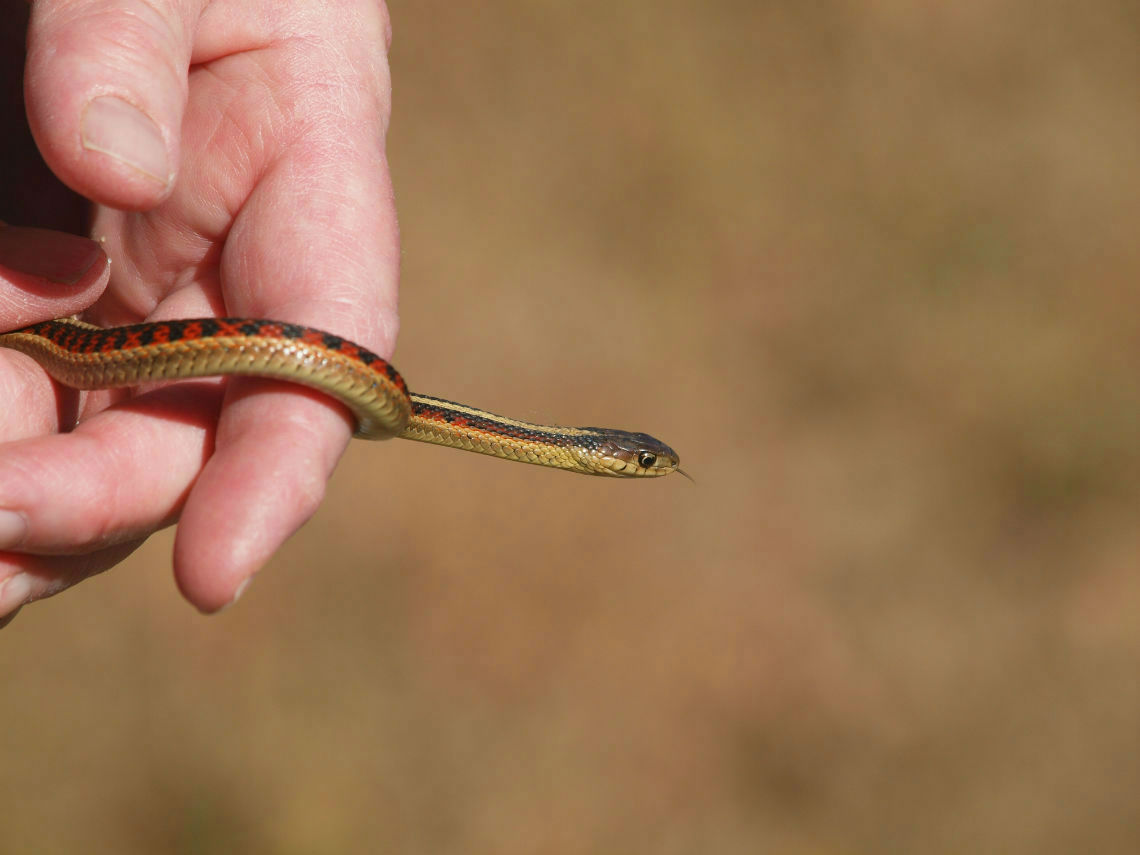Even the words we use to describe one of nature’s most misunderstood animals are enough to give you the creeps—slithery, slimy, sneaky, and poisonous—snakes! And summertime in Colorado is when you’re likely to have a snake encounter. Eew!
But wait a minute. Are snakes truly as bad as their reputation would have you believe?
Recently, we talked with Victoria Sutton, Park Interpreter at the South Platte Park Carson Nature Center in Littleton, and learned more about the nature of snakes in our area.
“I love snakes,” said Victoria. Originally from Arizona, a state that boasts 14 species of these reptiles, Victoria learned early on that snakes are an important part of our ecosystem. “They’re critical in the environment when it comes to things like population control for rodents and other small vermin. They not only hunt them, but they use their rattles to scare away rodents too.”
In Colorado we have about 23 species of snakes, but most people will only see a few in their day-to-day living. Snakes are, by nature, rather shy creatures and Victoria said that they are more likely to see and avoid you rather than the other way around.
So what kind of snakes are you likely to encounter in your own backyard? Should you be concerned about running across a rattlesnake as you dig in your garden?
First of all, Victoria said that unless you back up to a greenbelt, it is very unlikely you’ll run into a rattlesnake in your yard. In fact, you’re more likely to be hit by a car than be bitten by a rattler. While these reptiles generally like to inhabit terrestrial landscapes below 9,000 feet in elevation, they also tend to like tall grass areas and places where you’d find mammal dens like those of the prairie dog.
The best help in identifying which snake may be in your own yard is a field guide like Peterson’s Western Reptiles and Amphibians. It is difficult to say exactly what snake you’re likely to see, because, as Victoria pointed out, different snake species reside in Morrison than those as close as Highlands Ranch.
Still, some of the most common snakes in Colorado, besides the Western or Prairie rattlesnake and the Massasauga rattlesnake, are the garter, the bull snake, the king snake, and the water snake. In the Denver metro area, away from the water, the bull snake is very common, and commonly mistaken for a rattlesnake. We have microclimates that appeal differently to the snakes of the Rocky Mountains region.
Victoria introduced us to Houdini, a bull snake that resides at the Carson center. He was brown with black splotches and looked as if he could be a rattler. But Victoria pointed out that Houdini’s head is slender, without the telltale “shovel shape” or “diamond shape” indicative of his poisonous cousins. He also had a tapering tail, and no rattles or blunted tail end. She brought out a stuffed version of the rattlesnake in its classic striking pose, with raised head and s-shaped posture.
“Bull snakes are generally more laid-back in their personality,” said Victoria, “but if you see one in the posture position, it’s time to back off.”
One of the defenses for the bull snake is to imitate a rattlesnake, so it will use the end of its tail to rustle dry leaves around and create the classic “rattle sound” that indicates trouble for the unwary hiker or gardener.
We asked about what to do when you see a snake.
“They don’t want to hurt you,” said Victoria. “And for the most part they’re not going to attack.” She recommended standing still for a moment to reduce your threat to the snake you see, and then slowly back away. Snakes will not chase you.
Rattlesnakes hunt by holding still and striking small rodents as the mice, voles, or ground squirrels pass by. They are also creatures of habit, and stay close to the areas most familiar to them. If you didn’t have a rattlesnake in your yard last year, you’re not likely to have one there this year. When people stumble upon these ferocious creatures, the snakes are going to try these steps before biting:
- Camouflage – they are great at blending into the environment, both to hunt and to avoid being hunted by hawks, coyotes, and other snakes that prey on them. They’ll also “hide” from you if at all possible.
- The Rattle – Rather than thinking of this as a war cry, remember the rattle is a warning sound. Respect it and you can avoid a lot of trouble.
- The “S” Coil – If the rattlesnake still feels threatened it will inflate its body to look as big as possible, hissing and rattling as it does. By this time you should certainly heed its warning.
- The Strike – This can be interpreted as the “you asked for it, Buddy,” move. The rattlesnake has tried all its options and you haven’t gone away. It will strike. Interestingly, though, about one-third of the bites a rattlesnake performs on people are “dry” or without venom. The snake instinctively knows it needs that venom to subdue real victims, or it will starve.
Believe it or not, of the 8,000 to 10,000 poisonous bites people in the United States receive each year, about 2,600 to 3,300 happened because someone was trying to handle or kill the snake. As Victoria said, “just back away.”
Where snakes are concerned, the best neighbor is a neighbor that respects their privacy.
The following websites were used to supplement information for today’s blog post:
- Colorado State Parks Rattlesnake Management Document – Robert Fenwick
- Great photos of Colorado snakes can be found at Reptiles and Amphibians of Colorado
(Photo by lostinfog)






Leave A Comment